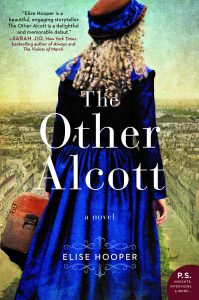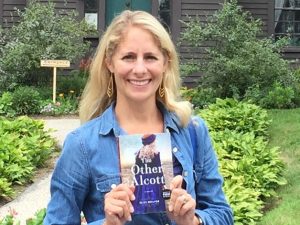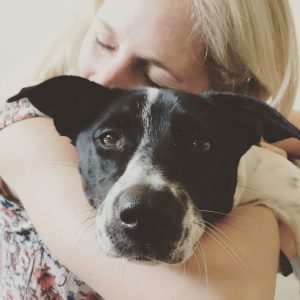Drunk on Ink Q & A with Shabnam Samuel and ‘A Fractured Life’ a memoir
Drunk on Ink is a blast interview series by Soniah Kamal author of the novel Unmarriageable a parallel retelling of Jane Austen’s Pride and Prejudice and set in contemporary Pakistan
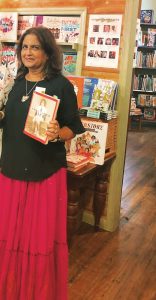
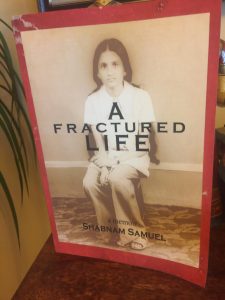
Shabnam Samuel is a writer, coach, social media trainer, and the founder of the Panchgani Writers’ Retreat, an international writing retreat based out of Panchgani, India. The retreat incorporates mindful living along with creativity and wellness following Ayurveda principles, with yoga, meditation and writing workshops. As a writer, Shabnam has been writing ever since she can remember. Her essays have been published online in Brain Child Magazine and Your Tango. Shabnam also hosts a local TV show called Dew Drops and Words that broadcasts to 2.4 million viewers on the MHz network in the Washington, DC area. You can find her on YouTube under the name ‘Dew Drops and Words’. Shabnam is also a business coach and she mentors with the Empowered Women International in Alexandria, Virginia, an organization that helps train low-income, immigrant, and refugee women on how to be a successful entrepreneurs.
About A Fractured Life.
Abandoned by her parents as a three-year-old, and ultimately leaving her home country India for a new life in America as a young mother of a three-year-old son, this is not only an immigrant’s story, but a poignant and powerful memoir that is at first, one of sadness and continuing adversity, but ultimately one of strength, purpose, and the universal triumph of hope. It is a story of dislocation, disruption, and despair, and brings focus to the silencing of girlhood and womanhood and how with time, love, and support we can work our way out of that silence.Raised by an orphan of the Russian Revolution and an Indian Sepoy who, during WWI was stationed in Iraq (Mesopotamia), her story arc begins in a small town called Cuttack in the East of India and takes her to the capital of the most powerful nation in the world, Washington DC. It is a humanizing story of mixed races, religion, and continents. Shabnam Samuel was twenty seven when she moved to the US, carrying with her a troubled marriage, an almost estranged husband, and a three-year-old son. Hoping to create a fresh start from everything that was holding her down, it took Shabnam twenty-five years of trials and tribulations to finally find her voice, her strength, and her place in this world.
SONIAH KAMAL: First author/book you read/fell in love with?
SHABNAM SAMUEL: The first author I fell in love with was Enid Blyton. The families that she created with the Famous Five, were families that I longed to belong to. They had everything, that I did not have.
To unwind: chai, coffee, water, wine?
Chai, Chai , all the way!
A novel, short story, poem, essay, anything you believe should be mandatory reading?
Okay, don’t laugh, Archie and Jughead comics!! In your youth to show you that life should be one where you can laugh and as an adult to tell you not to take life too seriously.
Any classic you wished you’d pushed through in your teens?
Moby Dick. I gave up mid way.
Favorite quote
I do not understand the mystery of grace-only that it meets us where we are and does not leave us where it found us”-
Anne Lamott. I am not sure which of her books this is from. I want to say Bird by Bird, but I could be wrong.
Favorite book to film?
The Godfather. Everything was so brilliantly portrayed. The voice, the intonations, the accent, just about everything.
Favorite Indie Book Store/s?
Curious Iguana in Frederick, MD
The one think you wish you’d known about the writing life?
That once you write a book (non-fiction) you are supposed to keep writing essays that revolve around your theme.
Does writing/publishing/marketing get any easier with each story/novel published?
I am not so sure. This is my first book.
Dog, Cat, Or?
Parrot.
Ideal vacation?
Sea, sun and my ideal partner.
Favorite book cover?
Can I say mine?
Favorite song?
As of now a Bollywood song called Hawayein from the movie Jab Harry Met Sejal.
Favorite painting/ work of art?
My son’s drawing of a lion and a poem he wrote to go with it when he was 9.
Any Lit Festival anecdote you want a share? A great meeting with a fan? An epiphany?
I was at the Bangalore Literature Festival in October and the women and girls who came up to tell me, how my book inspired them to write their own stories.
What is your favorite Austen novel, and film adaptation?
Sense and Sensibility. I loved the costumes, the drama, the humor the bonnets!!
Recommend a Small Press and/or Literary Journal?
Green Writers Press out of Vermont.
Last impulse book buy and why?
You know, I actually never buy books impulsively. I buy a lot of them but each one is carefully considered. I read mostly memoirs, but will buy all friends books that I am connected to.
More Drunk on Ink Interviews:
Mike Chen: Here and Now and Then, a novel
Ruth Franklin: Shirley Jackson A Rather Haunted Life, biography
Colleen Oakley: Before I Go, a novel
Emily Midorikawa: A Secret Sisterhood: The literary friendships of Jane Austen, Charlotte Bronte, George Eliot, and Virginia Woolf, biography
Shabnam Samuel: A Fractured Life, memoir
Elise Hooper: The Other Alcott, a novel
Anne Boyd Rioux: Meg, Jo, Beth, Amy: The Story of Little Women and Why It Still Matters, non fiction
Devoney Looser: The Making of Jane Austen, non fiction
Kristen Miller Zohn: The Currency of Taste- Gibbons Georgian Silver, coffee table book
Vanessa Hua, A River of Stars, novel
Chaitli Sen, The Pathless Sky, novel
Sonya Huber, Pain Woman Take Your Keys, memoir
Kathy Wilson Florence, Three of Cups, a novel
Sara Luce Look, Charis Books and More, independent book store
S J Sindu, Marriage of a Thousand Lies, a novel
Rosalie Morales Kearns, Kingdom of Men, a novel
Saadia Faruqi, Meet Yasmin, children’s literature
Rene Denfeld: The Child Finder, a novel
Jamie Brenner, The Husband Hour, a novel
Sara Marchant, The Driveway has Two Sides, memoir
Kirsten Imani Kasai, The House of Erzulie, a novel
Thrity Umrigar, The Secrets Between Us, novel
John Kessel, Pride and Prometheus, novel
Lisa Romeo, Starting with Goodbye: A Daughter’s Memoir of Love After Loss
Rachel May, An American Quilt: Unfolding a Story of Family and Slavery
Rebecca Entel, Fingerprints of Previous Owners, novel
Jamie Sumner, Unbound: Finding from Unrealistic Expectations of Motherhood
Falguni Kothari, My Last Love Story, novel
Tanaz Bathena, A Girl Like That, YA novel

